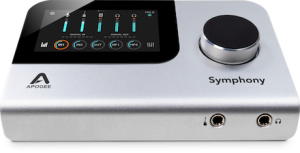Gear Review • Apogee Digital: Symphony Desktop Interface
The most basic function of Apogee Digital’s Symphony Desktop is its capability as a two-channel audio interface. Apogee has a range of portable interfaces available, but Symphony Desktop represents the company’s first offering of its top-quality converters in a desktop format that travels easily. Boasting a pair of Apogee’s flagship Symphony microphone preamps and analog inputs, Symphony Desktop earned high marks during a recording project undertaken for this review. A simple song called “Do it Again” was written and recorded at the Happy Club Studio in Wheaton, IL to compare the performance of Apogee’s four-channel Quartet (a commendable unit with its own merits) and Symphony Desktop. All parts were tracked directly into both units in succession using no outboard preamps, with settings and mic placement matched as identically as possible. Mixing engineer Miro Svetinsky recognized the general difference between the two units’ output. “The Symphony Desktop tracks were clearly more open and detailed than the Quartet tracks,” he said. You can hear the results at the comparison links below.
 A similar comparison was made previously between the Quartet and an optimized MOTU 828mkII interface, a contest that the Quartet easily won on the basis of sound quality. With its optical input, Symphony Desktop is a flexible 10×10 audio interface. Key features include DualPath workflow to permit low-latency recording with effects engaged, allowing singers to inhabit the vibe of a song while tracking. Users can control a choice of three versatile modeling preamps that provide capabilities parallel to top-end Apogee, Neve, and Ampeg hardware. Symphony Desktop can control print and monitor effects that are either bundled with Symphony Desktop or available as add-ons.
A similar comparison was made previously between the Quartet and an optimized MOTU 828mkII interface, a contest that the Quartet easily won on the basis of sound quality. With its optical input, Symphony Desktop is a flexible 10×10 audio interface. Key features include DualPath workflow to permit low-latency recording with effects engaged, allowing singers to inhabit the vibe of a song while tracking. Users can control a choice of three versatile modeling preamps that provide capabilities parallel to top-end Apogee, Neve, and Ampeg hardware. Symphony Desktop can control print and monitor effects that are either bundled with Symphony Desktop or available as add-ons.
The bundled ECS Channel Strip is a sound-shaping tool tuned by mixing guru Bob Clearmountain that provides equalization, compression, and saturation. Other available plug-ins include pristine reverb emulation and additional EQ and compression options painstakingly modeled after coveted tube and solid-state recording studio equipment. Apogee’s Control 2 software allows users to connect and control Symphony Desktop features with DAWs like Pro Tools and Logic Pro, as well as everyday functions like bringing audio from a turntable into a laptop for recording and playback. ($1495 MSRP; apogeedigital.com)
– Jeff Elbel
Comparison links:










